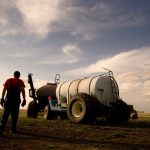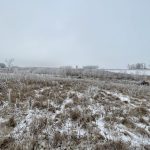
Tag Archives soil moisture

Moving from dry to wet
Improved moisture conditions can mean different strategies

Where the canola was: a history of Saskatchewan yields by soil climatic zone
Whether by nature, nurture or both, yields jumped in several zones around the turn of this century

Seeding in Alberta ahead of pace

Drought preparedness through soil and crop management
After each dry year, adapt your drought plan based on your experiences and what you learned

Snow and rain fall across the Prairies
Topsoil should have sufficient moisture for planting in next few weeks says analyst

It pays to adjust seeding rate based on moisture
Keep wheat plant count in line with moisture expectations — and limit the amount of tillering

Curb risk from moisture stress for less
A Manitoba agronomist offers up some tips for farmers on a budget

Subsurface irrigation called way of the future
Early adopters in southern Alberta are using drip lines to run water directly to crop roots

Managing irrigation with limited water
Some irrigation districts are advising users to brace for limits on available water

Precipitation cycles: When will the dry cycle end?
There's no way to predict from here what the 2024 growing season will provide


